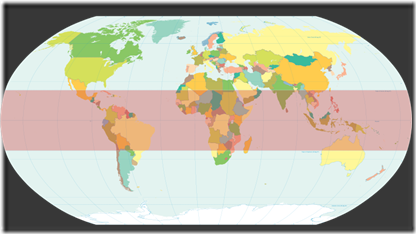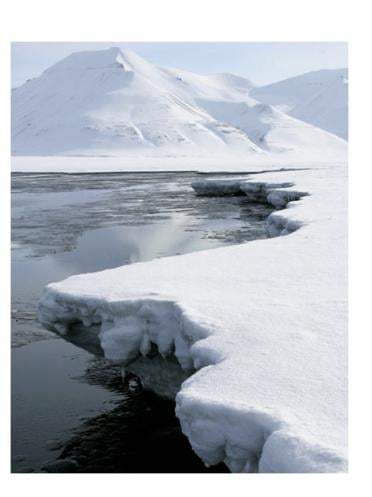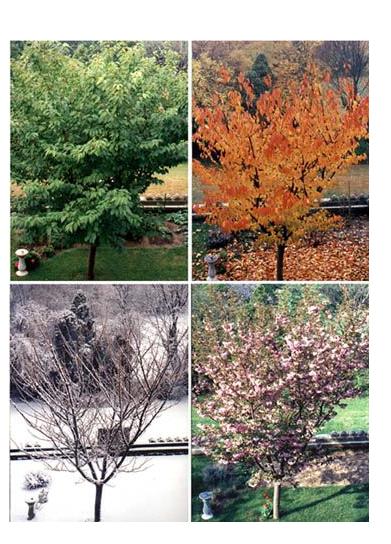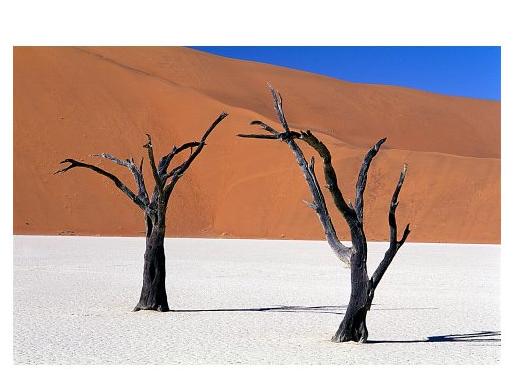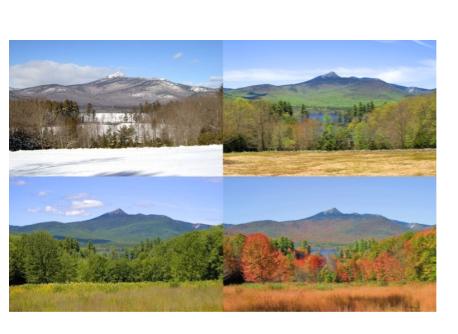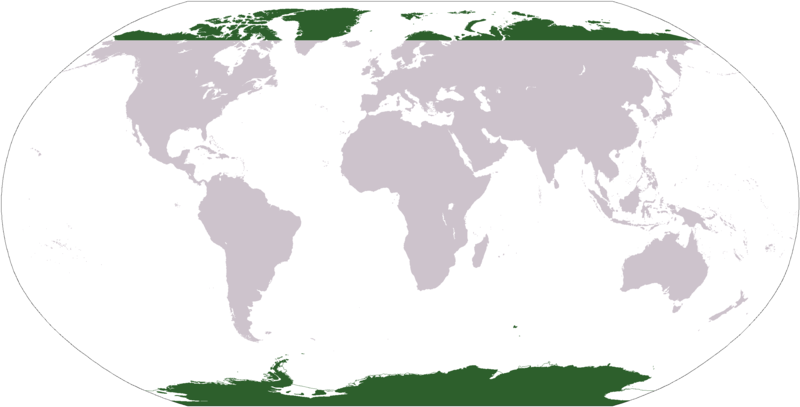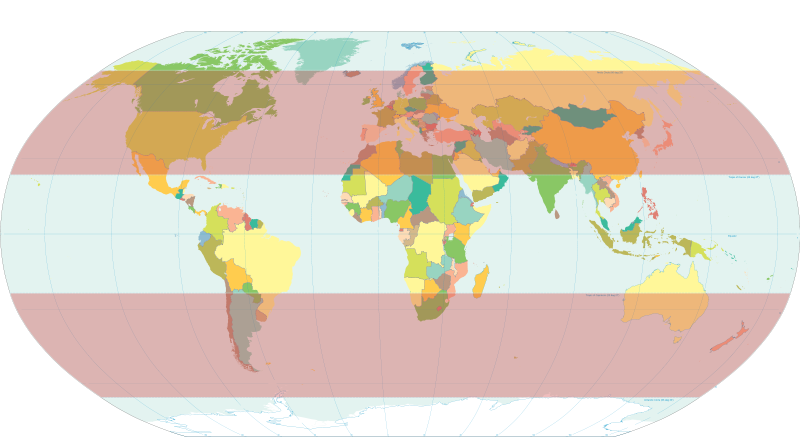Climates

This quiz will help you practice and review what we learned about climates!
- 1.
The areas highlighted in red have a ________ climate.
- A.
Tropical
- B.
Temperate
- C.
Polar
- D.
Arid
Correct Answer
A. TropicalExplanation
These areas, called the low latitudes, are near the Equator. The sun hits the Earth more strongly at the Equator.Rate this question:
-
- 2.
-Hot, rains a lot, located near the Equator. What type of climate do these statements describe?
- A.
Tropical
- B.
Temperate
- C.
Polar
- D.
Arid
Correct Answer
A. TropicalExplanation
The given statements of "hot, rains a lot, located near the Equator" suggest a climate that is characteristic of the tropical climate zone. In this type of climate, temperatures are consistently warm or hot throughout the year, and there is a high amount of precipitation, resulting in frequent rainfall. The location near the Equator indicates that the area receives direct sunlight, contributing to the hot temperatures. Therefore, the correct answer is tropical.Rate this question:
-
- 3.
Which type of climate is shown in the picture?
- A.
Tropical
- B.
Temperate
- C.
Polar
- D.
Arid
Correct Answer
C. PolarExplanation
The picture is likely to show a polar climate because it is associated with cold temperatures and icy landscapes. Polar climates are typically found near the Earth's poles, such as the Arctic and Antarctic regions. These areas experience extremely cold temperatures, with long winters and short summers. The picture may also depict features like glaciers or icebergs, which are commonly found in polar regions.Rate this question:
-
- 4.
Which type of climate is shown in the picture?
- A.
Tropical
- B.
Temperate
- C.
Polar
- D.
Arid
Correct Answer
B. TemperateExplanation
The picture likely shows a temperate climate because the vegetation appears to be a mix of deciduous and evergreen trees, which are commonly found in temperate regions. The absence of extreme heat or cold, as well as the moderate amount of rainfall, also suggest a temperate climate. Additionally, the lack of tropical features such as palm trees or dense rainforest further supports the idea of a temperate climate.Rate this question:
-
- 5.
Which type of climate is shown in the picture?
- A.
Tropical
- B.
Temperate
- C.
Polar
- D.
Arid
Correct Answer
D. AridExplanation
Arid means "dry."Rate this question:
-
- 6.
-Cold all the time-Snows a lot -Dry with little rainfallWhich type of climate do these statements describe?
- A.
Tropical
- B.
Temperate
- C.
Polar
- D.
Arid
Correct Answer
C. PolarExplanation
The given statements describe a climate that is cold all the time, snows a lot, and is dry with little rainfall. These characteristics are typically associated with polar climates, which are found near the Earth's poles. In polar climates, temperatures are consistently low, and precipitation mainly occurs in the form of snow. The lack of rainfall and dry conditions further support the classification of this climate as polar.Rate this question:
-
- 7.
-Dry all the time-Hot most of the timeWhich type of climate do these statements describe?
- A.
Tropical
- B.
Temperate
- C.
Polar
- D.
Arid
Correct Answer
D. AridExplanation
arid means dry.Rate this question:
-
- 8.
This picture shows which type of climate?
- A.
Tropical
- B.
Temperate
- C.
Polar
- D.
Arid
Correct Answer
B. TemperateExplanation
The picture shows a landscape with moderate temperatures, lush greenery, and a mix of deciduous and evergreen trees. This indicates a temperate climate, which is characterized by moderate temperatures and distinct seasons. Tropical climates are typically hotter and have a greater abundance of rainforests, while polar climates are characterized by extreme cold temperatures and arid climates are dry with little vegetation. Therefore, the correct answer is temperate.Rate this question:
-
- 9.
-4 seasons-warm in the summer-cold in the winter-Medium amount of rainfallWhich type of climate do these statements describe?
- A.
Tropical
- B.
Polar
- C.
Temperate
- D.
Arid
Correct Answer
C. TemperateExplanation
The given statements describe a climate with four seasons, warm summers, cold winters, and a medium amount of rainfall. This type of climate is known as a temperate climate. In temperate regions, the weather patterns and temperatures vary throughout the year, with distinct seasons. The moderate amount of rainfall in this climate supports a diverse range of vegetation and ecosystems.Rate this question:
-
- 10.
Average summer temperature: 30 degrees F. Average winter temperature: 2 degrees F. Average rainfall: very little. Which type of climate does this data describe?
- A.
Arid
- B.
Tropical
- C.
Temperate
- D.
Continental
Correct Answer
D. ContinentalExplanation
An average summer temperature of 30 degrees Fahrenheit, an average winter temperature of 2 degrees Fahrenheit, and very little rainfall, describes a Continental Climate. Continental climates are characterized by significant temperature differences between summer and winter, with cold winters and warm to hot summers.Rate this question:
-
- 11.
Average summer temperature: 75 degrees F. Average winter temperature: 45 degrees F. Average rainfall: medium amount. Which type of climate does this data describe?
- A.
Tropical
- B.
Temperate
- C.
Polar
- D.
Arid
Correct Answer
B. TemperateExplanation
The given data describes a temperate climate. This is indicated by the average summer temperature of 75 degrees F, which is warm but not excessively hot, and the average winter temperature of 45 degrees F, which is cool but not extremely cold. The medium amount of rainfall also suggests a temperate climate, as it is not excessively wet or dry.Rate this question:
-
- 12.
Average summer temperature: 85 degrees F. Average winter temperature: 80 degrees F. Average rainfall: lots. Which type of climate does this data describe?
- A.
Tropical
- B.
Temperate
- C.
Polar
- D.
Arid
Correct Answer
A. TropicalExplanation
The given data describes a tropical climate. A tropical climate is characterized by high temperatures throughout the year, with average summer temperatures around 85 degrees F and average winter temperatures around 80 degrees F. Additionally, the mention of "lots" of rainfall indicates a high level of precipitation, which is typical of tropical climates.Rate this question:
-
- 13.
Average summer temperature: 102 degrees F. Average winter temperature: 85 degrees F. Average rainfall: very little. What type of climate do these statements describe?
- A.
Tropical
- B.
Temperate
- C.
Polar
- D.
Arid
Correct Answer
D. AridExplanation
Arid means dry. Deserts are usually hot during the day but can get very cold at night.Rate this question:
-
- 14.
Which type of climate do the green areas have?
- A.
Tropical
- B.
Temperate
- C.
Polar
- D.
Arid
Correct Answer
C. PolarExplanation
they are also called the high latitudes.Rate this question:
-
- 15.
What type of climate do the red shaded areas have?
- A.
Tropical
- B.
Temperate
- C.
Polar
- D.
Arid
Correct Answer
B. TemperateExplanation
The red shaded areas have a temperate climate. This type of climate is characterized by moderate temperatures, with distinct seasons including warm summers and cool winters. It is typically found in regions located between the tropics and the polar regions. The temperate climate is often associated with a variety of vegetation and is suitable for a wide range of agricultural activities.Rate this question:
-
- 16.
Polar climates get very little rainfalll.
- A.
True
- B.
False
Correct Answer
A. TrueExplanation
Most of the time it is too cold to rain in a polar climate. Instead, the moisture falls as snow. So, polar climates are actually very arid!Rate this question:
-
Quiz Review Timeline +
Our quizzes are rigorously reviewed, monitored and continuously updated by our expert board to maintain accuracy, relevance, and timeliness.
-
Current Version
-
Aug 06, 2024Quiz Edited by
ProProfs Editorial Team -
Dec 10, 2010Quiz Created by
Ms.sutherland
- Air Quizzes
- Atmosphere Quizzes
- Beach Quizzes
- Biome Quizzes
- Conservation Quizzes
- Desert Quizzes
- Diffusion Quizzes
- Disaster Quizzes
- Ecosystem Quizzes
- Evolution Quizzes
- Fire Quizzes
- Flower Quizzes
- Forest Quizzes
- Global Warming Quizzes
- Lake Quizzes
- Landform Quizzes
- Mountain Quizzes
- Natural Resource Quizzes
- Nature Of Matter Quizzes
- Osmosis Quizzes
- Plant Quizzes
- Pollution Quizzes
- River Quizzes
- Sea Quizzes
- Season Quizzes
- Snow Quizzes
- Soil Quizzes
- Water Quizzes
- Wildlife Quizzes
- Wind Quizzes
 Back to top
Back to top



